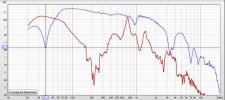Hi.
Thanks for the links.
In these links, they are discussing about port chuffing.
As per my understanding, chuffing usually occurs when the port is trying to output frequencies at which it is supposed to give its peak output. In our case, this region is around the "system resonance" frequency which is about 38.2 Hz as shown in the plot that I attached. The port is the "star" in this range of frequencies. I think chuffing happens because the flow of air inside the port turns from a laminar flow to a turbulent flow, which means instead of air being able to move smoothly through the port, it is finding it hard to move so smoothly. This could be due to design of the port itself due to various factors.
One of the techniques that is used to mitigate chuffing to some extent is to ensure that when we model the low frequency bass reflex alignment for woofer using the T/S parameters in softwares like WinISD etc, we keep the dimensions of the port and the resultant port tuning such that the port velocity is under 17-20 meters/sec (to be conservative) even at sufficiently high power levels that we want the system to play.
The issue that we are discussing here has more to do with the port output "leaking" into the midrange. These are the frequencies where we see narrow peaks in the port output (red line in the figure that i attached in previous post) around 700 Hz. I think at these frequencies, the port is supposed to "play dead", like its not there. The entire sound radiation should be taken care of by the midwoofer to whom we have entrusted this duty to.. However, in this particular case, the port is sticking out like a sore thumb and calling attention to itself.
Thanks
Vineeth
I agree. I was referring to unwanted noise from the ports (chuff?). If I don’t hear this I assume it’s all fine. I was probably unclear in my understanding of the questions.
If you haven't see this before, you might find this interesting. The wonders of science!

Edit: I found this in my "notes". This is for only ONE pipe resonance:
One pipe resonance occurs at F=c/(2*L+0.8*d)
where:
c = speed of sound (m/s)
L = length of vent (m)
d = diameter of vent (m)
How other resonances are calculated, I have no clue.
@Vineethkumar01, with your background, maybe you can help and educate.
If you have seen augerpro's posts about this on DIYA then I'm quite sure he has linked to the Harman paper that I was referring to. You should also look in his posts for the paper from N.B. Roozen formerly of Philips that I had pointed him to. Augerpro was also doing extensive tests on ideal enclosure material/s to build speaker enclosures of. THAT, is WAY more audible than pipe resonances et al.
Sure. Thanks for the information and equation..

I am already going through the KEF paper. I will go through the Philips paper and augerpro's posts once more, during my breaks from work..

Once I gather more info, I will try and summarize the relevant port-related (good practices) material here.
From my preliminary understanding, I think the equation you gave is for the finding out the fundamental resonant frequency of the column of air enclosed by the port. I remember seeing a similar equation long back over at the techtalk parts express forum. Such resonant behaviour (identified by narrow peaks in frequency response) will also seen at the harmonics of this fundamental frequency (F). ie at 2*F, 3*F, 4*F.... for the system under consideration. In the plot that I had posted also, it can be seen upto the 1st harmonic clearly, I think. (Ideally we dont want to hear any of those coming out from the port).
Edit:
I went through the KEF LS 50 white paper, Roozen's paper and relevant parts of FM augerpro's related thread here:
I've always thought they wouldn't show up in impedance, but others have claimed they can and I'm pretty sure I've seen some posts here showing that. The impedance is the easiest place to see resonances of any kind. A sealed box is the easiest to look at, vents can cause all sorts of problems...

www.diyaudio.com
The Roozen paper was very interesting to read. It calls the kind of resonant behaviour I saw in plots posted above above as acoustic port resonances. In general, one way in which noises from the port occur is due to "chuffing" (vortex formation), which is broadband in its behaviour, meaning it is spread out over a wide range of frequencies. The other kind of noise is what we saw as sharp peaks (acoustic port resonances) in my plot, which occur approximately at integer multiples of the frequency, whose wavelength is equal to half the effective length of the port.
In the case that I presented above, This occurs at F= (n*c/2*L), where n is a positive integer (takes values 1, 2,3,... corresponding to the fundamental frequency (n=1), and the harmonics (other values of n =2,3,....) ), c = speed of sound, L = effective length of the port. In my particular example, I had a rectangular slot port with effective length (L)= 23 cm in length, c= 350 m/s, etc. This gives the fundamental frequency of acoustic port resonance at around 730 Hz, 1st harmonic occurring around 2*730 = 1460 Hz,.. and so on... This behaviour is clearly visible in the above graph.
In order to solve these kind of port resonances, even acadamically, we might need to adopt advanced port designs. Harman has a special flexible port. Roozen paper says about a specific design with holes poked at the center and 3/4the distance from one end. Augerpro's experiments also confirm their effectivety, and he has produced his own variations of the above ports. These specialized ports apart from the KEF one achieve high port resonance suppression, but seems to cause some amount of harmonic distortion. Again all these occur at high drive levels (when we are try to play music at high volumes).
So, even if the port resonances themselves are audible or not in real world uses cases (specifically with music) if we take care of these issues in port design, we might be able to sleep better at night....

This answers my questions about audibility of these and I am happy with the strategies I learnt for their potential mitigation..
Thanks everyone for your contributions.
Thanks
Vineeth




